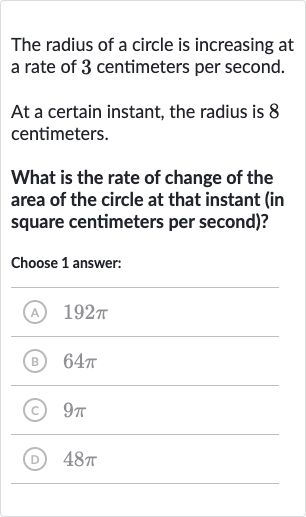AI tutor
Welcome to Bytelearn!
Let’s check out your problem:

The radius of a circle is increasing at a rate of centimeters per second.At a certain instant, the radius is centimeters.What is the rate of change of the area of the circle at that instant (in square centimeters per second)?Choose answer:(A) (B) (C) (D)
Full solution
Q. The radius of a circle is increasing at a rate of centimeters per second.At a certain instant, the radius is centimeters.What is the rate of change of the area of the circle at that instant (in square centimeters per second)?Choose answer:(A) (B) (C) (D)
- Circle Area Formula: First, we need to know the formula for the area of a circle, which is , where is the area and is the radius.
- Derivative Calculation: Next, we need to find the derivative of the area with respect to time, , since we're looking for the rate of change of the area. This means we'll use the chain rule to differentiate with respect to time.
- Chain Rule Application: The derivative of with respect to is . Then, since the radius is changing with respect to time, we multiply by , which is the rate of change of the radius with respect to time.
- Rate of Change Calculation: We know that (given in the problem). Now we just plug in the values: .
- Final Result Calculation: Substitute and into the equation: .
- Final Result Calculation: Substitute cm and cm/s into the equation: .Calculate the rate of change of the area: square centimeters per second.
More problems from Area of quadrilaterals and triangles: word problems
QuestionGet tutor help
QuestionGet tutor help
QuestionGet tutor help
QuestionGet tutor help
QuestionGet tutor help
QuestionGet tutor help
QuestionGet tutor help
